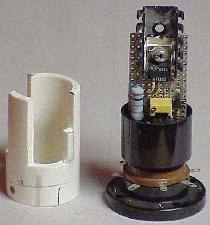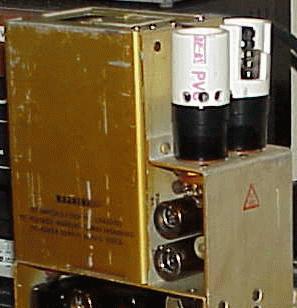This design is a solid-state replacement for ballast tube R-32 in the AM-65/GRC audio amplifier. When the AM-65 is used as a power supply for the RT-70 transceiver, R-32 regulates the RT-70’s tube filament current. The original part is described as follows in the service manual for the AM-65/GRC (TM 11-5039):
R-32 RESISTOR, thermal: current through lamp greater than .58 amp w/4.3 v measured across lamp and less than .625 amp w/9.7 v measured across lamp; designed for DC; T-9 bulb, 2 7/8″ lg o/a; intermediate octal base; Amperite type #6-4; Fed Tele & Rad part/dwg #GH-2677-2.
The original Signal Corps part number is 3Z6925-3.19.
This solid-state replacement is nothing more than a DC current regulator. The design should be easily adaptable to replace other ballast tubes with similar characteristics which are used to regulate DC currents. This design will NOT work correctly in AC circuits. Unlike the original ballast tube, this unit IS sensitive to the polarity of the applied voltage. I suggest that you examine your AM-65 and make sure that the socket for R-32 is wired correctly before installing this replacement.
I normally avoid modifying vintage radio gear, and I do not like to use non-original replacement components. However, my first priority is usually to get a radio back on the air. I designed this unit to replace the hard-to-find ballast tube in my AM-65 audio amplifier without damaging or irreversably modifying the amplifier. Because this is a plug-in unit and does not require any other circuit modifications in the AM-65, I can easily replace it with the correct tube at any time.
CONSTRUCTION DETAILS:
Here is the schematic diagram, in both Adobe PDF and Postscript formats:
 |
amp6-4.pdf | (32k) |
 |
amp6-4.ps | (36k) |
I built my prototype on a small piece of perforated circuit board, which I trimmed to snugly fit inside a short piece of 1″ PVC pipe. I used a heat sink from my junk box for transistor Q1; I happened to have a heat sink which would fit inside the PVC pipe without touching it. I mounted the board inside an octal tube base, and cut a piece of pipe such that when slipped over the end of the board, the entire assembly would have the same dimensions as the original ballast tube. I cut away the side of the PVC pipe so that air could flow over the heat sink, and drilled a hole in it so that I can adjust VR1. I attached the pipe to the tube base with electrical tape. In operation, the unit gets very warm and the tape softens, so I plan to replace the tape with glue or epoxy. Note that Q1 will get pretty hot (it will typically dissipate about 3.5 watts in normal operation), so make sure that you provide an adequate heat sink. R1 will also get warm, because it will disipate 600 mW.
The pictures below show the ballast replacement with the PVC pipe installed and removed, and both the ballast replacement and a solid-state thermal relay replacement installed in an AM-65:



ADJUSTMENT:
I recommend the following method for adjusting the unit for the first time. The first step verifies that the unit can correctly regulate current, and hopefully will keep it from being damaged if you made any wiring mistakes. The second step adjusts the unit to the deliver the correct amount of current.
Step 1:
When testing the unit for the first time, connect it in series with an ammeter to a variable DC power supply with an adjustable current limiter. Make sure that you observe the correct polarity. Before applying power, set the power supply’s current limiter to 100 mA, and its voltage to 6 volts. Apply power, and adjust VR1 until the unit draws 50 mA. Verify that the current through the unit does not vary by more than 1 mA or so as you vary the applied voltage between 4 volts and 10 volts. The current should begin to taper off below about 3 volts or so. Return the applied voltage to 6 volts.
Step 2:
After you complete step one successfully, the unit should be passing about 50 mA of current. Raise the power supply’s current limiter setting to at least 700 mA, and then adjust VR1 until the unit passes 600 mA of current.
OTHER USES:
You should be able to use this unit in other equipment which uses ballast tubes to regulate DC current. You may need to change the tube base pin connections to match the pinout and polarity of a given piece of equipment. The unit is adjustable to deliver up to about 1.2 amps. Make sure that transistor Q1 has an adequate heat sink for your desired application. I found that the unit can begin regulating correctly with about 3 volts applied to it. The applied voltage must be below 32 volts to avoid burning out U1.
Hi,
Maybe a little bit late but I found several 3Z6925-3.19. NOS parts in my stock, Celsior Type GH2677 – 2 FR 3 dated 1956 in good condition.
Should anyone be interested, kindly drop me a line. I am located in France.